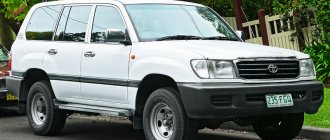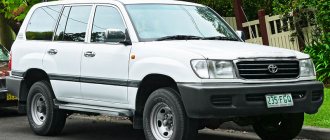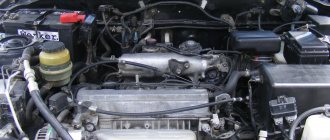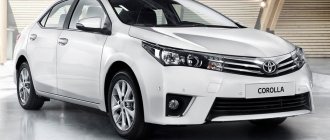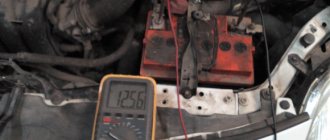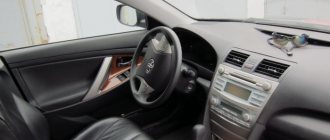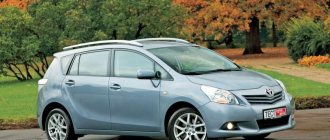Toyota Probox is a station wagon for commercial use produced by Toyota since 2002.
The main distinguishing feature of the Toyota Probox is its simplicity; the car was produced for small businessmen and outdoor enthusiasts. The low price, starting from $12,000, allowed the station wagon to gain popularity not only in Japan, but also in Russia on the secondary market, despite high duties.
In the article we will talk about the details of the Toyota Probox, technical characteristics, engines, production history, prices and the analogue with left-hand drive.
First generation 2002-2014
Toyota Probox was released in June 2002, the main development concept is to ensure ease of use and reduce costs through inexpensive materials and components. The car is available in 2 modifications, cargo-passenger and passenger, there are also differences in the drive wheels, the van is available with both front-wheel drive and all-wheel drive. Probox is built on a platform borrowed from the first generation Toyota Vitz (MC platform).
Toyota Probox is equipped with three engines. The base 1.3 liter engine with the index 2NZ-FE has a power of 88 horsepower and 121 Hm of torque, this is the most economical version, in the combined cycle it consumes only 5.7 liters per 100 km.
Next comes a 1.5-liter engine with the index 1NZ-FE, this unit produces 103 horsepower and 132 Hm of torque. There is also a 1.4-liter 1ND-TV turbodiesel engine with a capacity of 75 horsepower and 170 Hm of torque.
The transmission can be selected from Super ECT (4-speed AT) and 5-speed MT, but vehicles equipped with the 1ND-TV engine only have a 5-speed manual transmission, with 2NZ-FE/1NZ-.
Toyota Probox and Succeed station wagons: now hybrids
This pair of workhorses is perhaps the most conservative cars on the Japanese market. They appeared in 2002 and since then have undergone a minimum of changes, maintaining the Spartan spirit and extremely simple design. But it is precisely for this set of qualities that Probox and Succeed are loved by both Japanese merchants and Russian buyers of used cars in the Far East. By the way, besides the name, these two models differ only in that they are sold through different sales networks, of which Toyota has three in Japan. But now the station wagons have undergone almost the most serious modernization in all 16 years of production life: they have been implanted with a hybrid power plant.
The technology is entirely borrowed from the mass-produced Toyota Aqua hatchback (aka Prius C in other markets). This is a naturally aspirated 1NZ-FXE with a volume of 1.5 liters (74 hp, 111 Nm), an electric motor 1LM (61 hp, 169 Nm) and an electromechanical variator. Peak power of the installation is 100 hp. versus 109 horsepower for a purely gasoline version with a 1.5 engine and a CVT. The nickel-metal hydride traction battery with a capacity of only 6.5 Ah is located under the rear seat.
The hybrid drive promises not only reduced fuel consumption (3.6 l/100 km on the JC08 cycle versus 5.1 l for the gasoline version), but also tax benefits (in Japan, of course), which is even more important in the case of commercial vehicles. However, gas-electric versions also have a number of disadvantages. They can only have front-wheel drive (all-wheel drive transmission is also offered for gasoline ones), and due to the increased curb weight (plus 70 kg), the rated load capacity was reduced from 400 to 350 kg. In addition, the volume of the gas tank has been reduced from 50 to 42 liters.
By the way, in addition to the hybrid installation, the Probox and Succeed models have acquired other new features. Moreover, studying their list, you cannot say that it’s 2021. The standard package now includes an immobilizer and a USB port for charging gadgets, and for the first time climate control and a heated driver's seat are offered for an extra charge for twins. Another important innovation is that the holder on the front panel has been enlarged, into which you can place a smartphone or a work notebook. In contrast to these changes is the modified Safety Sense electronic complex, which can now recognize pedestrians and stop the car in front of them.
The hybrid version can be ordered in any of four existing trim levels, including the cheapest empty one. But if prices for petrol Probox and Succeed in Japan start from 12 thousand dollars for a car with a 1.3 engine and from 13,700 dollars for a version with a 1.5 engine, then a hybrid station wagon will cost at least 16,100 dollars. Toyota still has no plans to supply twin models outside of Japan.
Options
In Japan, Toyota Probox is sold in 4 trim levels: • GL; • DX Comfort Package; • DX; • DX-J.
The top-end GL package includes electric retractable rear-view mirrors, air conditioning, front windows, and you can additionally order body-colored bumpers and body-colored mirrors. The DX modification is equipped with automatic windows and air conditioning. The basic DX-J comes without air conditioning and only with a 1.3 liter engine. It is worth noting that the station wagon is offered in 5 colors, but the most common color is white.
On August 1, 2005, some improvements occurred. In addition to the use of manual leveling headlights, all vehicles began to have high-mounted brake lights, an AM/FM radio, and 2 speakers with a multi-electronic tuner (all grade vans and the "F" station wagon). The special station wagon "F Extra Package Limited" has undergone improvements based on the base car and continues to be sold. The base "DX-J" trim was cancelled. On September 30, 2007, sales of cars with a diesel engine 1ND-TV ceased. On June 1, 2010, improvements occurred again. Toyota Probox with a 1.5 liter engine has become 15% more economical and harmful emissions have decreased. On April 26, 2012, a 3-point seat belt and a headrest were added to the rear seats, and emissions of harmful gases were reduced. A year later, in 2013, it stopped selling, and in 2014 a deep restyling of the model was released.
Toyota Voxy equipment
When installing interior equipment, Japanese manufacturers have already become a tradition of using the best materials, and Toyota Voxy is no exception.
The main feature of the Toyota Voxy car is its capacity of 7 passengers, who can fit in three rows of seats. Another point characteristic of all cars of this class produced in Japan is the perfectly flat floor of the cabin, which makes it possible to move from one row to another.
Pleasant little things like curtains on the windows and an electric rear door are also a good advantage. The cabin itself has many possibilities for transformation, thanks to the arrangement of the seats on skids and the ability to install them in any desired position.
The trunk of the car is small, since the main space is occupied by passenger seats. Its volume can be significantly increased by removing the third row of seats and moving the second row forward all the way. According to reviews from car owners, it allows you to transport cargo from 700 kg to 1 ton, and the total length of the cabin makes it possible to transport cargo up to 2800 mm in length.
Specifications
• Production date: 2002-2014 • Body type: station wagon
Dimensions:
• Length: 4195 mm • Height: 1510 mm • Width: 1695 mm • Ground clearance: 150 mm • Wheelbase: 2550 mm • Drive type: front and all-wheel drive • Vehicle weight: 1030 kilograms • Fuel tank capacity: 50 liters
Unit 1.3 l • Index: 2NZ-FE • Volume: 1299 cm3 • Power: 88 hp 6000 rpm • Torque: 123 Hm 4400 rpm • Consumption: 5.7 liters per 100 km • Number of cylinders: 4
Unit 1.5 l • Index: 1NZ-FE • Volume: 1496 cm3 • Power: 103 hp 6000 rpm • Torque: 132 Hm 4200 rpm • Acceleration to 100 km/h: 10.1 seconds • Consumption: 6.3 liters per 100 km Unit 1.4 liters (turbodiesel) • Volume: 1364 cm3 • Power: 75 hp at 4000 rpm • Torque: 170 Hm at 2000 rpm
Second generation
In 2014, a new generation of Toyota Probox was released; externally, the car maintained continuity and the same square shape can be traced. The engineers retained everything that the first generation was so loved for: good cargo capacity, reliable technical components, strong suspension, functional interior and, of course, low cost.
While maintaining the same advantages, the engineers were able to make the car more comfortable, since the owners spend a lot of time in the car, and persistently asked to make the Probox more comfortable.
Ergonomics have become better, the front seats can be fully reclined and you get a full-fledged reclining area. We also increased the power of the air conditioning and added a cabin filter, which greatly improved the air in the cabin. As has already been said, externally the Toyota Probox has remained virtually unchanged, but in the meantime the design has become fresher. The dimensions remained unchanged, with the exception of the length, the length increased by 50 millimeters.
The power units remained from the first generation, but significantly improved to the modern level. These are 1.3 and 1.5 liter engines with a capacity of 95 and 103 horsepower, respectively. If the engines remain the same, then the transmission has changed, now for all power units it is a continuously variable variator, with it the engine feels soft and without jerking, and the variator helps save fuel.
Appearance
In 2021, all three varieties of the Voxy / Noah / Esquire models were subjected to a planned restyling, which resulted in changes to the appearance. They affected bumpers, optical devices and radiator grilles. Headlights in all assemblies, without exception, operate on LEDs.
The technical part has not received any changes. When viewed from the front of the car, attention is drawn to the special design of the headlights and the short distance from the bumper to the road, similar to sports cars. It will be impossible to travel with it on Russian roads, since it is designed for the perfectly smooth roads of Japan.
Besides its size, its features include its design, with a large air intake and chrome trim. In other countries, this bumper design can only be found in tuned versions.
More: Review of Toyota RAV4 2000-2006
Specifications
• Date of production: 2014 – present • Country of origin: Japan • Body type: station wagon
Dimensions: • Length: 4245 mm • Height: 1525 mm • Width: 1695 mm • Ground clearance: 140 mm • Wheelbase: 2550 mm • Drive type: front-wheel drive and all-wheel drive • Vehicle weight: 1090 kilograms • Fuel tank capacity: 50 liters
Unit 1.3 l • Index: 2NZ-FE • Volume: 1299 cm3 • Power: 95 hp 6000 rpm • Torque: 123 Hm 4400 rpm • Consumption: 5.7 liters per 100 km • Number of cylinders: 4
Unit 1.5 l • Index: 1NZ-FE • Volume: 1496 cm3 • Power: 109 hp 6000 rpm • Torque: 132 Hm 4000 rpm • Consumption: 5.5 liters per 100 km • Number of cylinders: 4
Technical stuffing
The Japanese-made Toyota Voxy minivan has two powertrain options. The first is traditionally petrol, with a volume of 2 liters and a power of 158 hp. Fuel consumption is approximately 8 liters. It works in tandem with a V-belt variator.
Of greatest interest is the hybrid power plant taken from the Toyota Prius. The main engine is a two-liter gasoline engine with a power of 99 hp. It will be paired with an 82 hp electric motor.
The gearbox is an electromechanical variator. The location of the traction batteries was chosen to be under the floor in the area of the front seats. The hybrid version also features reduced fuel consumption, about 4 liters per 100 kilometers.
There are no prospects for Toyota Voxy to appear for sale in Russia, since the Japanese manufacturer does not plan to produce cars with left-hand drive. It can only be sold privately, exclusively in the Far East.


